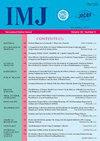BLOOD PRESSURE, HYPOCHONDRIA AND DEPRESSION: MATHEMATICAL MODELS OF RELATIONSHIP
Q4 Medicine
引用次数: 0
Abstract
Modern clinical diagnostics has standards and medical systems for the diagnosis of hypertension, advanced information technology. Mathematical models of the relationship between systolic blood pressure and psychological indices of hypochondria and depression have been described. Methods of mathematical statistics were applied as follows: factor, cluster, discriminant, regression analyzes, Markov chains, polynomial splines and neural networks, they were implemented in software products, such as NeuroModelDBPM, "Monitoring", VerMed. The presented model of interaction of systolic arterial pressure, Hs−hypochondria, D−depression confirms an importance of these states at an initial stage of arterial hypertension and allows the allocation of four options of psychosomatic relations in patients: organ and system somatic defeats of psychosomatic character, somaticized psychiatric reactions, reactions of exogenous type. It has been shown that disharmonious personality traits, risk factors, disorder of chronobiological structure of blood pressure, left ventricular hypertrophy and its diastolic dysfunction contribute to the formation of nosogeny in hypertension. Their development is hindered by harmonious personality traits, keeping a healthy lifestyle, minimal changes in the chronobiological structure of blood pressure, a slight degree of left ventricular hypertrophy and its diastolic dysfunction. The leading cardiovascular risk factors in patients with hypertension are stress, burdened heredity, low physical activity, carbohydrate abuse, higher education and high socioeconomic status. Nosogeny in hypertension should also be considered as a risk factor, as well as should be taken into account in the stratification of the overall cardiovascular risk and accomplishing a proper adjustments. Key words: arterial hypertension, mathematical statistics, arterial pressure, hypochondria, depression, information technology.血压、疑病症和抑郁症:关系的数学模型
现代临床诊断有高血压诊断的标准和医疗体系,有先进的信息技术。已经描述了收缩压与疑病症和抑郁症的心理指标之间关系的数学模型。数理统计方法应用于因子、聚类、判别、回归分析、马尔可夫链、多项式样条和神经网络,并在NeuroModelDBPM、“Monitoring”、VerMed等软件产品中实现。所提出的收缩动脉压、Hs−疑病症、D−抑郁相互作用模型证实了这些状态在动脉高压初始阶段的重要性,并允许在患者中分配四种心身关系选择:心身特征的器官和系统躯体失败、躯体化精神反应、外源性反应。研究表明,不和谐的人格特征、危险因素、血压时间生物学结构紊乱、左心室肥厚及其舒张功能障碍是高血压病病因形成的原因。他们的发展受到和谐人格特征、保持健康生活方式、血压时间生物学结构变化最小、轻度左心室肥大及其舒张功能障碍的阻碍。高血压患者的主要心血管危险因素是压力、遗传负担、低体力活动、碳水化合物滥用、高等教育和高社会经济地位。高血压的鼻源性也应被视为一个风险因素,在对总体心血管风险进行分层并进行适当调整时也应予以考虑。关键词:动脉高压,数理统计,动脉压,疑病症,抑郁症,信息技术。
本文章由计算机程序翻译,如有差异,请以英文原文为准。
求助全文
约1分钟内获得全文
求助全文
来源期刊

International Medical Journal
医学-医学:内科
自引率
0.00%
发文量
21
审稿时长
4-8 weeks
期刊介绍:
The International Medical Journal is intended to provide a multidisciplinary forum for the exchange of ideas and information among professionals concerned with medicine and related disciplines in the world. It is recognized that many other disciplines have an important contribution to make in furthering knowledge of the physical life and mental life and the Editors welcome relevant contributions from them.
The Editors and Publishers wish to encourage a dialogue among the experts from different countries whose diverse cultures afford interesting and challenging alternatives to existing theories and practices. Priority will therefore be given to articles which are oriented to an international perspective. The journal will publish reviews of high quality on contemporary issues, significant clinical studies, and conceptual contributions, as well as serve in the rapid dissemination of important and relevant research findings.
The International Medical Journal (IMJ) was first established in 1994.
 求助内容:
求助内容: 应助结果提醒方式:
应助结果提醒方式:


